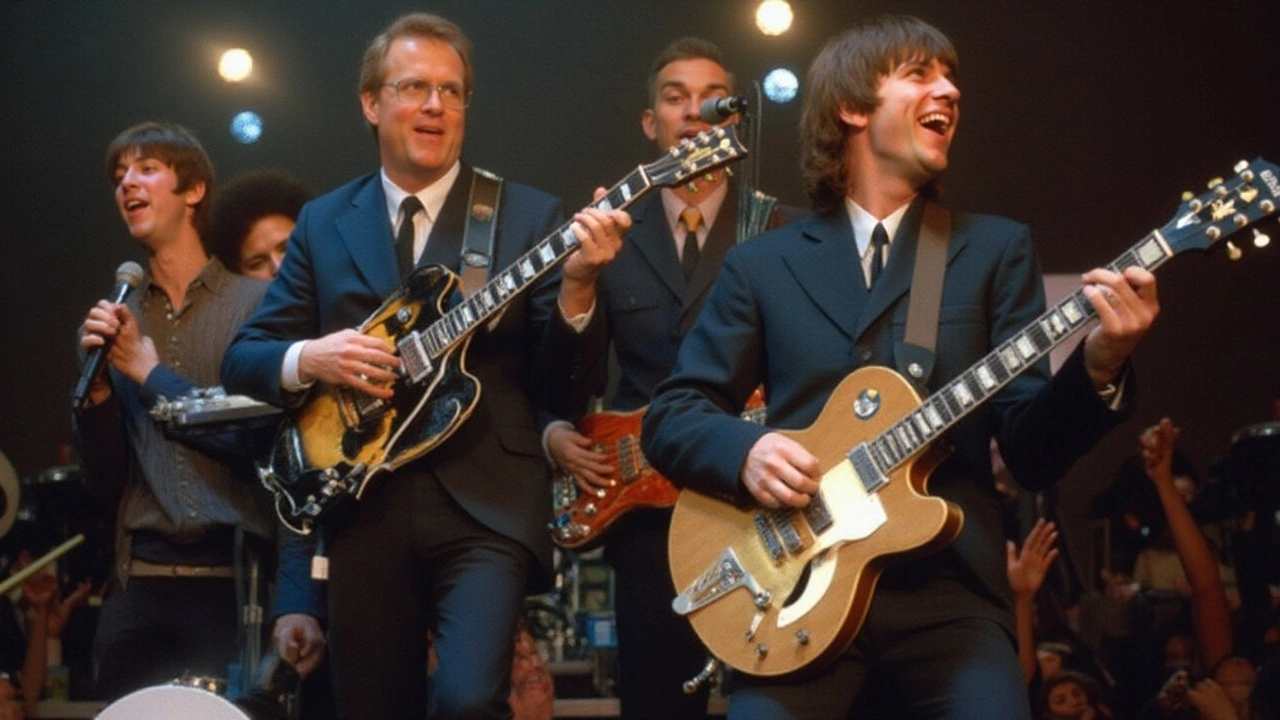Rock music, with its electrifying beats and rebellious spirit, has transformed from a niche genre into a global sensation that transcends borders. Born in the mid-20th century, rock has captivated millions and become a cultural force influencing fashion, politics, and social movements. Its journey from the underground to the mainstream is a fascinating story of passion, innovation, and sheer musical prowess.
By diving into the history of rock, understanding its major milestones, exploring its cultural impact, and looking at its modern evolution, we can appreciate why this genre holds a special place in hearts all over the world.
- The Birth of Rock Music
- Rock's Major Milestones
- Cultural Impact of Rock Music
- Modern Evolution and Global Reach
The Birth of Rock Music
The birth of rock music can be traced back to the mid-1950s, a time when the world was recovering from the aftermath of World War II. It was a period marked by significant social changes and a yearning for new forms of expression. Rock music emerged as a blend of various genres, including blues, country, jazz, and gospel. The mixture of these diverse sounds gave birth to a fresh, electrifying genre that would soon take the world by storm.
One of the pivotal moments in the history of rock music was the release of “Rock Around the Clock” by Bill Haley & His Comets in 1954. This track, often credited as the first rock and roll song to top the charts, paved the way for the genre's mainstream acceptance. The energetic and rebellious vibe of the music resonated with the youth, who were looking for an outlet to express their growing dissatisfaction with the conservative norms of the era.
Elvis Presley, often referred to as the King of Rock and Roll, played a crucial role in bringing rock music to the forefront. With his charismatic stage presence, soulful voice, and controversial dance moves, Elvis became an idol for many. His rendition of songs like “Heartbreak Hotel” and “Hound Dog” not only topped the charts but also challenged the status quo, making rock music a symbol of youthful defiance.
“If there had been no Elvis, there would have been no Beatles.” - John Lennon
Other pioneers like Chuck Berry, Little Richard, and Buddy Holly also contributed to the genre's early development. Chuck Berry's guitar riffs and showmanship, Little Richard's flamboyant persona and powerful voice, and Buddy Holly's songwriting and distinctive sound all played significant roles in shaping the early rock scene. These artists broke racial barriers and brought together fans from different backgrounds, uniting them through the power of music.
The rise of radio and television also played a significant role in popularizing rock music. Shows like “American Bandstand” introduced rock and roll to a wider audience, allowing artists to reach households across the United States. The genre's infectious energy and catchy rhythms captivated listeners, cementing its place in popular culture.
As rock music started gaining momentum, the world saw the birth of rock bands that would go on to define the genre. Bands like The Beatles and The Rolling Stones emerged in the 1960s, taking inspiration from early rock and roll and infusing it with their unique styles. The Beatles' arrival in the United States in 1964, known as the British Invasion, marked another significant milestone in the genre's evolution. Their innovative approach to songwriting and recording techniques set new standards in the music industry.
In summary, the birth of rock music was a revolutionary period characterized by a fusion of different musical styles, influential artists, and significant cultural shifts. Its electrifying sound and rebellious spirit resonated with the youth, positioning it as a powerful force in the world of music. As we journey further into the genre's evolution, we'll see how rock music continued to break barriers and change the course of popular music forever.

Rock's Major Milestones
Rock music's journey is adorned with significant milestones that have shaped its identity. Starting with the 1950s, we witness the genre’s birth as artists like Elvis Presley, Chuck Berry, and Little Richard revolutionized the music scene. Their energetic performances and innovative sounds broke new ground, making rock a symbol of youth rebellion and freedom. Elvis's gyrating hips and magnetic voice earned him the title 'The King of Rock and Roll,' and his influence extended far beyond music into fashion and culture.
The 1960s saw the British Invasion, led by bands like The Beatles and The Rolling Stones, which injected fresh energy into rock music. The Beatles, in particular, became a global phenomenon, transforming from charming pop icons to innovative artists who explored new musical territories. Their appearance on 'The Ed Sullivan Show' in 1964 is often cited as a defining moment that heralded a new era in rock music. This period also saw the rise of psychedelic rock, with bands like Pink Floyd and The Doors pushing the boundaries of what rock could be.
The 1970s introduced a range of sub-genres, including punk and heavy metal. Punk rock, characterized by its raw sound and anti-establishment attitude, gave voice to a generation disillusioned with society. Bands like The Ramones and The Sex Pistols became the face of this movement, providing not just music but an ethos of DIY and rebellion. Heavy metal, on the other hand, brought a louder, more aggressive sound with bands like Black Sabbath and Led Zeppelin leading the way. This decade also saw the rise of arena rock, with bands like Queen and AC/DC filling stadiums and creating larger-than-life performances.
As we moved into the 1980s, rock music continued to evolve with the advent of new wave and alternative rock. The use of synthesizers became more prominent, and bands like U2 and The Police enjoyed massive success. This period also saw the emergence of MTV, which revolutionized how music was consumed and promoted. Music videos became a vital part of an artist's success, and the visual aspect of rock music grew in importance. Michael Jackson's 'Thriller,' although not strictly rock, demonstrated the power of the music video and its potential to elevate a song to legendary status.
The 1990s brought the grunge movement, with bands like Nirvana, Pearl Jam, and Soundgarden emerging from Seattle to dominate the music scene. Grunge was marked by its raw sound, introspective lyrics, and a departure from the polished production of the '80s. Nirvana's 'Nevermind' album, featuring the iconic track 'Smells Like Teen Spirit,' became a defining moment for the genre. This decade also saw the continued rise of alternative rock, with bands like Radiohead and R.E.M. pushing the boundaries of the genre.
In the 2000s, rock music faced new challenges with the rise of digital downloads and streaming. However, it adapted and continued to thrive. The garage rock revival, led by bands like The White Stripes and The Strokes, brought a raw, stripped-down sound back to the forefront. Indie rock also saw significant growth, with bands like Arctic Monkeys and Arcade Fire gaining worldwide recognition. Festivals like Coachella and Glastonbury became massive platforms for rock artists to reach new audiences.
"Rock and roll might not solve your problems, but it does let you dance all over them." – Pete Townshend
Each of these milestones has played a crucial role in shaping rock music into the global phenomenon it is today. From its rebellious roots to its modern-day adaptations, rock continues to inspire and influence generations of music lovers worldwide.

Cultural Impact of Rock Music
Since its inception, rock music has had a profound impact on culture worldwide. It has done more than just provide a soundtrack to generations; it has influenced fashion, language, and even political movements. Back in the 1950s and 60s, rock and roll challenged the norms of society and pushed boundaries. Before rock, no other genre had ever questioned authority and tradition quite so boldly, making it a revolutionary force.
In the 1960s, the counterculture movement found its voice in rock music. Bands like The Beatles and The Rolling Stones didn't just make music; they created anthems that reflected the social upheaval of the times. Songs became a powerful medium to express opinions on civil rights, gender equality, and anti-war sentiments. Woodstock, arguably the most famous music festival of all time, showcased how passionate people were about rock and how the genre was a vessel for political and cultural expression.
Rock music continued to evolve and influence fashion trends. The rebellious fashion of the 70s, epitomized by artists like David Bowie and bands like KISS, became part of the genre's identity. Leather jackets, band t-shirts, and wild hairstyles became synonymous with rock culture. Even today, rock-inspired fashion remains a staple in mainstream clothing lines, proving how deeply ingrained the genre is in society’s fabric.
"If you tried to give rock and roll another name, you might call it ‘Chuck Berry,’" said John Lennon, pointing to how seminal figures in rock shaped the genre’s identity. Names like Jimi Hendrix, Janis Joplin, and Freddie Mercury didn’t just play music, they upset existing norms and opened up new ways of thinking about art, life, and even identity.
Language and slang used in rock music have filtered into everyday speech. Words like “cool,” “groovy,” and “hip” owe their popularity to rock culture. This unique lingo still influences the way people talk and interact today. It isn't just confined to casual conversation; rock-inspired language has even made its way into literature, film, and television, becoming part of the global lexicon.
The socio-political impact of rock is another essential aspect to consider. During the 1980s, bands like U2 and artists like Bruce Springsteen used their platforms to address issues such as economic disparity and human rights. They turned concerts into fundraising events and awareness campaigns, turning fans into activists and music into a force for change. Even now, modern rock bands continue to tackle pressing issues, from climate change to mental health, using their music to inspire action and change.
The influence of rock extends to other forms of art as well. It has impacted film, with movies like “Almost Famous” and “Bohemian Rhapsody” making significant cultural contributions. These films not only celebrate the essence of rock music but also introduce its powerful narratives to new generations. Art exhibitions themed around rock music and its icons draw millions of visitors, underlining how the genre has permeated visual arts as well.
Moreover, the digital age has only amplified rock music's cultural impact. Platforms like YouTube and Spotify allow legendary bands and emerging artists alike to reach a global audience instantly. This wide reach has made it easier for rock music to continue influencing cultures around the world, from remote villages to bustling metropolises. Social media trends, featuring classic rock songs as soundtracks to viral videos, further testify to rock's enduring appeal.

Modern Evolution and Global Reach
Rock music's modern evolution is a testament to its enduring appeal and adaptability. In recent decades, the genre has branched out in countless directions, driven by technological advances and a blend of cultures from around the world. Events like the rise of the Internet and digital music platforms have democratized access to music, allowing rock to find new audiences across the globe.
One of the significant changes in rock music's landscape is its fusion with other genres. Bands like Linkin Park merged rock with hip-hop, creating a unique sound that resonated with a broad audience. This blending of genres has kept rock music fresh and relevant, attracting fans from different musical backgrounds. Countries that once played a minimal role in the rock scene are now major contributors. For instance, Japanese rock bands like X Japan and ONE OK ROCK have gained international acclaim, showcasing how rock music has spread and adapted worldwide.
Technology has also played a critical role in rock music's global outreach. Streaming services like Spotify and Apple Music have made it easier than ever to discover and listen to rock music from any corner of the world. This has not only increased the genre's fanbase but has also allowed artists to reach audiences they could never have dreamed of before. The access to analytics and real-time data enables artists to understand their global audience better and tailor their music accordingly. According to a 2020 report by the International Federation of the Phonographic Industry (IFPI), rock remained one of the top five most consumed genres globally, proving its lasting appeal.
The live music scene has also evolved, with rock festivals becoming global phenomena. Events like Glastonbury in the UK, Rock am Ring in Germany, and Lollapalooza in the US attract thousands of fans from around the world. These festivals not only celebrate rock music but also unite people from different cultures. The experience of attending a rock concert has transformed, with the integration of advanced stage technology and interactive elements, making it a more immersive experience for the audience.
Despite these modern advancements, the core elements of rock music remain unchanged. The powerful guitar riffs, vigorous drumbeats, and passionate vocals continue to be the genre's defining characteristics. New generations of rock bands like Greta Van Fleet are drawing inspiration from classic rock while also adding their contemporary twist, ensuring the genre's longevity.
"Rock and roll might not solve your problems, but it does let you dance all over them." - Pete Townshend
In many ways, rock music serves as a cultural bridge, connecting people across different backgrounds and generations. Its ability to adapt while staying true to its roots makes rock a truly global phenomenon. Whether it's through online platforms, international tours, or iconic festivals, rock music continues to captivate and inspire.





